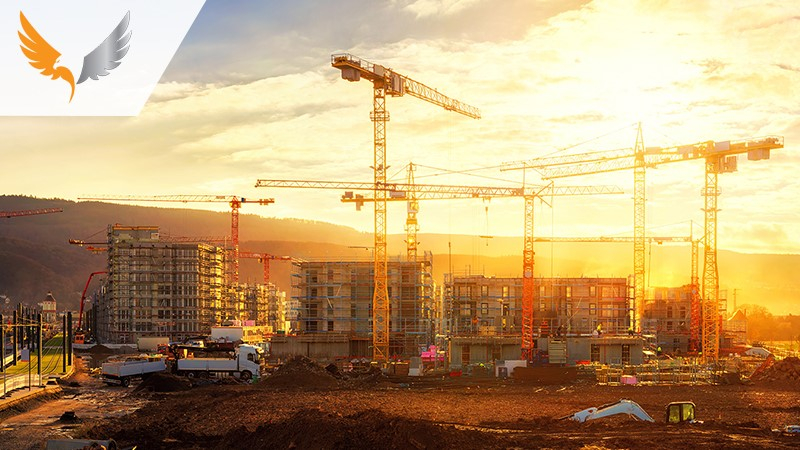Editorial Feature
Emerging Technologies
Words By: Drone Major
How Drones, Robotics and Autonomous Systems Are Being Utilised in the Construction Sector.
Technology develops at such a pace that the extent of emerging capabilities, or more precisely - The increasing commercial viability of Drones within the construction sector, may not be fully realised where it is needed.
This article details innovative approaches to ‘Robotics, and Autonomous Systems’ (RAS), aiming to encourage ‘out of the box’ thinking while noting that some solutions may involve larger investment to initiate a new level of autonomy in consideration of contemporary systems.
RAS has a lower barrier of entry for many manufacturers in areas where regulations, development, and control of operations are of vital importance, with its nearest comparison (in regard to purpose, size and relative low cost and consumerisation) being a hybrid of both aerospace and the internet of things (IoT).

The integration of current, and emerging technologies significantly compresses the development cycle of new systems and allows for the rapid introduction of these systems to the marketplace.
Use cases for Robotics, and Autonomous Systems can be categorised into three areas forming a ‘baseline’ for industry.
1. Critical and urgent
2. Critical but not urgent
3. Commercial
The following examples describe RAS technology across three main areas: -
1. Critical and Urgent:
RAS is making an impact through its speed of execution and delivery of output while completely eliminating, or substantially reducing the risk of harm to personnel.
RAS’s ability to quickly reach difficult or inaccessible areas within working environments provides a definitive advantage over traditional methods, emphasised by its ability to be deployed into hazardous areas at a moment’s notice, therefore creating a more immediate dimension to safety and inspection scenarios. Additionally, it is anticipated that the use of RAS in these circumstances can significantly reduce monetary cost to clients and stakeholders (such as insurance and project planning).
Drones equipped for monitoring with sophisticated video and imaging equipment can be used to:
- Improve site security and increase protection from theft, interference with assets or internal infrastructure.
- Perform enhanced inspections by use of better thermal imaging techniques.
- Verify structural integrity in construction projects, such as bridges and buildings.
- Deliver environmental monitoring, where sensors can quickly identify air quality degradation.
2. Critical and non-urgent:
Further consideration is made towards safety and the mitigation of future risks.
- Drones have the ability to manoeuvre and position themselves accurately within inaccessible settings (either from altitude or within subterranean environments). This enables the precise reporting of security threats or infrastructure degradation - a good example being the inspections of turbine blades over the North Sea.
- The consistency delivered by RAS provides early warnings to changes in structure and the environment before they become critical.
- RAS delivers a greater accuracy in operations that helps to prevent ‘hand-over’ oversights between parties, diminishing overall irregularities while reducing the costs to rectify mistakes.
- Through instantaneous reporting, real-time data feeds can greatly enhance the ability of management to oversee large projects.
3. Commercial.
Increasingly, the drone industry is being utilised for low value and repetitive tasks, moving towards construction efficiency and cost-effectiveness. RAS can transport materials, assembly components, tooling, and equipment over air, land, and sea.
- Systems with enhanced capabilities can be used for excavation and earthworks. Again, consistency of precision is one of the many advantages – reducing margins of error.
- Examples of RAS systems that automate concrete laying and bricklaying already exist. The growing sophistication of 3d printing technology supports these advances.
- In support of the workforce - the potential where a tool is broken, wrong or missing, a replacement can be quickly retrieved from an on-site storage facility to the place of operation. This alleviates any disruption to the individual while reducing safety concerns connected with inter-site movement.
- Productivity can be expedited through integrated high-resolution cameras and sensors such as LiDAR. These visual technologies accurately, and at ‘speed’, survey construction sites, deliver 3D maps, and provide topographical data.
- Sensory output can be integrated into project planning with the potential to enhance supporting aspects such as, Building Information Management (BIM).
Drone Major’s expertise lies in understanding the capabilities of drone technology, and importantly evaluating possible use cases for a wide range of applications, matching service providers with organisations, while effectively managing the process to ensure the ‘possible’ becomes a reality.
If you would like to keep informed about latest developments and use cases join our global supplier platform – Become a Drone Major Supplier
If you have a challenge where you think drones, robotics or autonomous systems could be the answer and you would like to join our construction sector working group, please get in touch using the button below.




